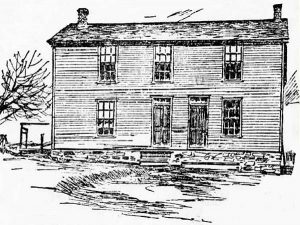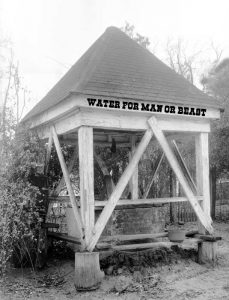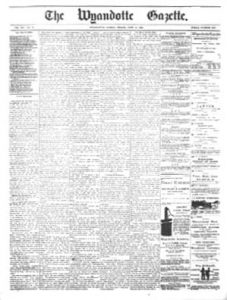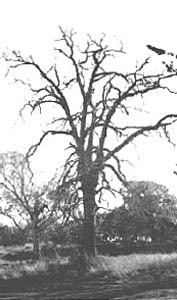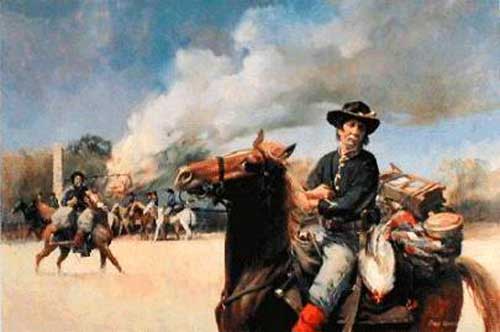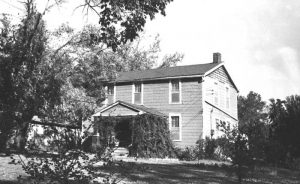Six-Mile Tavern was established just a few miles west of Quindaro, Kansas, on the road between Wyandotte (Kansas City) and Leavenworth in 1853. A suitable place to stay overnight was needed with much travel along the road. One of the stage lines running along the road was Kimball, Moore & Co., which ran from Westport to Weston, Missouri by way of Six-Mile and Leavenworth.
The land where it stood was bought from a Wyandotte Indian by Joseph A. Bartles, who ran the tavern with his son Theodore. It was a stage tavern, and the stop was where the first change of horses was made on the express stage running from Jefferson City, Missouri, through Kansas City, Wyandotte, Leavenworth, and St. Joseph. It stood just six miles from the ferry which crossed the Kansas River at Wyandotte City.
For a time, the inn was known as Bartle’s Tavern, but it could not escape the name of “Six Mile.” It was a large two-story building with nine large rooms, a wine cellar, secret closets for arms and ammunition, and a barroom. These rooms were finished in highly polished black walnut, including the doors, window casings, floors, stairways, closets, bar, cupboard, and fireplace mantels.
Just east of the tavern was a rock well which, for 60 years, quenched the thirst of the travelers. A sign hung from the top of the frame above the well declared, “Water for man and beast.”
The Inn served as a high-class hostelry for a few years, appealing only to the very best patronage. But the boom days were soon over. The competition between the steamboats plying the Missouri River and the fast express stage lines was so great that the tavern did not prove as profitable as its owner anticipated.
Joseph and Theodore Bartles, who were Free State advocates, were frequently caught up in the cross-border violence between Kansas and Missouri before and during the Civil War. Throughout the war, bands of Redlegs, Bushwhackers, and outlaws would often use “Public Houses” as rendezvous points in Kansas and Missouri.
Six Mile Tavern became one of the rendezvous points of the famous Red Legs, a secret band of Union guerillas who took advantage of these times along the border to rob travelers and plunder homes and farms for miles in both Missouri and Kansas. The secret closets in the inn were filled with ammunition, swords, and muskets, and sometimes men were stationed in a secret room at the head of the stairway from which they could see the front entrance and shoot down anyone who attempted to search or capture the tavern.
At that time, this area of eastern Wyandotte County was quite rough, with deep ravines and steep hills, and heavily forested. With most of the land owned by the Wyandot and Delaware tribes, it was an ideal cover for Bushwhackers, guerrillas, and deserters.
On August 3, 1861, the Wyandotte Gazette summed up the situation:
“Thirteen murders had been committed in the county in the past two years; none had been punished.”
Other papers were full of accounts of robbery, horse theft, and kidnapping of free blacks by visitors from across the Missouri River. The citizens of Wyandotte met this critical situation with a people’s court, which often administered punishment by horsewhipping and hanging.
On one occasion, after a man and his son were relieved of their belongings, they made the mistake of threatening to return with several friends to demand restitution. However, their captors declared the man and his son “rebels” and hanged them from a tree across the road from the old tavern.
Six-Mile House became a well-known rendezvous for many vicious gangs. On July 17, 1862, the citizens at the courthouse in Wyandotte held a mass meeting and formed a “Committee of Safety,” which was determined to tear down the tavern.
The next day the committee journeyed out to see Six-Mile House proprietor Theodore Bartles. However, Bartles had already heard that the committee had been formed and had ridden to Fort Leavenworth for help. When the committee arrived at the tavern, they were surprised to find a company of soldiers encamped around Six-Mile. Under orders from General James G. Blunt, the committee members were quickly told that there would be no destruction of property, and the members of the committee were taken to the fort and required to put up a bond to keep the peace.
Though it would seem that Union authorities would have also wanted the Six-Mile Tavern and the outlaw Redlegs, who indiscriminately robbed, murdered, and stole livestock for their own personal gain, disbanded, this was not the case. One reason may have been that the Redlegs were often employed as scouts by the Union Army because they were very familiar with the roads and trails in Missouri and Kansas.
Though the Wyandotte citizens had failed to get rid of Six-Mile Tavern in July, they met again on August 26, 1862, and drew up the following proclamation at a public meeting:
“WHEREAS: Our duty to our country is paramount to all others: and,
WHEREAS, the best-authenticated facts warrant us in the belief that an irresponsible band of armed men crossed the Missouri River from Wyandotte, none of whom were citizens thereof, on the night of August 22, for the double purpose of stealing Negroes and horses and to that end did steal a number of both and collect them on the bank of the river opposite Wyandotte, with a view to crossing into Kansas through Wyandotte; and,
WHEREAS, They stated that their headquarters were in Wyandotte;
RESOLVED, that while we are in favor of using all means in our power for crushing this rebellion, we unqualifiedly condemn kidnapping, Negro stealing, and horse-stealing; that we regard bushwhacking and jayhawking as the natural products of rebellion, moral deformities, and disorganizing in their tendencies and producing war, conflagration, and destruction!”
Though the publishing of this proclamation probably gave the citizens of Wyandotte some moral satisfaction, it changed nothing as the violent Bushwhacking and Jayhawking continued throughout and after the Civil War.
On December 18, 1862, a man named Smith was shot at Six-Mile House by a posse looking for horses stolen near Westport. Several of his companions were taken prisoner.
The Wyandotte Gazette also reported on July 16, 1863, a party of Bushwhackers crossed the Missouri River above Parkville, Missouri, with the intent to burn Wyandotte and Six-Mile. Some of these guerillas were caught and taken to Kansas City for trial.

Theodore Bartles obviously did well for himself after running the Six-Mile Tavern, as this was his home in Kansas City, Kansas in 1887.
William E. Connelley, in his book Quantrill and the Border Wars, published in 1910, said that he had been a long acquaintance with Theodore Bartles, who he described as being of a better class of “Red Legs.” His writing also states that Bartles admitted that he was a famous shot with the revolver and had even defeated “Wild Bill” Hickock in contests of marksmanship. Bartles also said he tried to warn the people of Lawrence, Kansas, of William Quantrill’s raid on August 21, 1863. Sending a Shawnee Indian named Pelathe from Six-Mile House on a fine thoroughbred horse across the Delaware reservation. Unfortunately, Pelathe wasn’t able to get there in time. By the time he reached the Kansas River across from Lawrence, the raiders had just fired the first shots upon the doomed city.
Even after the Civil War was over, banditry continued in the area. A newspaper reported a robbery in the area on November 11, 1865, and the next week, Dr. J. B. Welborn and wife were fired upon with buckshot through the living room window. Both survived, and later, Dr. Welborn would plat the area, and the new settlement would take his name, with a church, schoolhouse, blacksmith shop, a store, a hotel, and a tobacco factory. It received a post office in February 1874. However, the post office was short-lived, as it closed in September 1878 and moved to Braman Hill, one mile south.
Joseph A. Bartles died in 1877, and some time afterward, the Six-Mile Tavern was sold to James K. P. Barker. For years, the old house still held its beautiful black walnut bar with its large, handsomely polished arch decorated with hand carvings.
However, in 1894, part of the old structure had fallen into disrepair, and Barker cut the building in two and moved the front part of the old Six Mile tavern north a few blocks, while the back “L” section was moved about 200 feet east to become part of a barn. Barker then built a larger modern home on the former site.
Also See:
Kansas Jayhawkers – Terror in the Civil War
Sources:
Farley, Alan W.; Annals of Quindaro: A Kansas Ghost Town, 1856
Nevada, Missouri Daily Mail
Rootsweb

